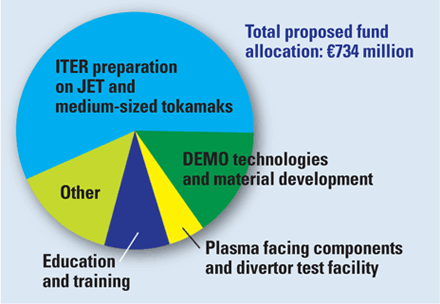 As the new year dawned, nuclear fusion researchers in the European Union woke to an entirely new funding system aimed at sharpening their focus on generating energy. Gone are the annual block grants to national fusion laboratories; now, teams must compete to participate in "work packages" supporting the international ITER reactor in France and preparing for a prototype power reactor before the middle of the century. "It's a substantial change in the way we work," says Francesco Romanelli, acting head of EUROfusion, a consortium of all of Europe's fusion labs that will manage the new program.
As the new year dawned, nuclear fusion researchers in the European Union woke to an entirely new funding system aimed at sharpening their focus on generating energy. Gone are the annual block grants to national fusion laboratories; now, teams must compete to participate in "work packages" supporting the international ITER reactor in France and preparing for a prototype power reactor before the middle of the century. "It's a substantial change in the way we work," says Francesco Romanelli, acting head of EUROfusion, a consortium of all of Europe's fusion labs that will manage the new program.
The change is the handiwork of the European Union's nuclear research arm, Euratom. It funds both ITER construction, shouldering 45% of the cost—a €6.6 billion share by the time the reactor is completed in 2020—and related fusion research in labs across the continent. That is the part of the budget that the new system redirects.
In the old system, in place since the 1950s, Euratom simply gave each of the national labs a lump of money every year equal to as much as 20% of the lab's budget and gently coordinated research. Euratom also funded the only common facility, the Joint European Torus (JET) reactor in Culham, U.K., through the European Fusion Development Agreement (EFDA).
In 2011, Euratom appointed a panel to recommend how to organize fusion research in the European Union's next 7-year financial period, starting in 2014. Headed by Albrecht Wagner, former head of the DESY particle physics lab in Germany, the panel recommended a more mission-oriented approach focusing on fusion energy. "If ITER is not a success, there is no need for future research," says Alain Bécoulet, head of France's Research Institute for Magnetic Fusion.
In 2012, Euratom tasked EFDA with drawing up a road map for refocusing Europe's fusion efforts. Published at the beginning of 2013, the road map called for the European Union to concentrate on finishing and operating ITER while also preparing for its successor, a power-producing prototype, dubbed DEMO. In response, Euratom announced that the annual grants would cease at the end of the year and that the fusion community must devise a 5-year program of research based on the aims of the road map.
Since then, the heads of the fusion labs have been working furiously to comply, and they finalized the work program last month. The program, which Euratom will spend the next 3 months evaluating, includes a campaign of experiments on JET to simulate ITER operation plus experiments at smaller reactors across Europe. There's money for technology R&D for ITER and DEMO, for training future fusion scientists, and for a neutron source to test materials in the sort of neutron bombardment they will experience in a working reactor. The program also hedges its bets by supporting work on stellarators, an alternative fusion technology that could play a role if ITER fizzles.
Bécoulet worries that the program focuses too much on the future—ITER operation and DEMO—and not on the immediate needs of ITER construction. "We're very upset with the proposal," he says, adding that the program "needs to focus more on what is urgent now." Romanelli responds that the program already addresses urgent needs, with 85% of the funding directly or indirectly supporting ITER. "ITER is the first priority," he says.
Source: sciencemag.org



















































































